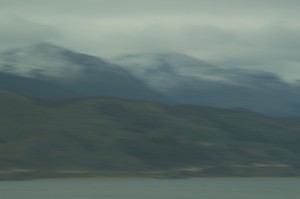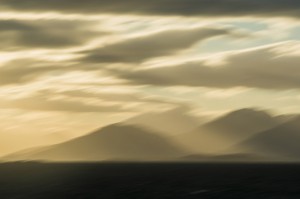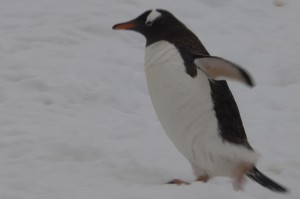 Walking down the extended pier, I passed the eerie 91-passenger ship whose windows were being replaced after the recent storm blew them out and forced her back to port. Just past her, I saw our Ocean Diamond, which comfortingly was a much larger vessel – higher, taller and longer. As I stood with the other 180 passengers boarding this 300’ long ship, I exhaled, feeling more comfortable about crossing the 500-mile wide Drake Passage considered among the roughest oceans in the world.
Walking down the extended pier, I passed the eerie 91-passenger ship whose windows were being replaced after the recent storm blew them out and forced her back to port. Just past her, I saw our Ocean Diamond, which comfortingly was a much larger vessel – higher, taller and longer. As I stood with the other 180 passengers boarding this 300’ long ship, I exhaled, feeling more comfortable about crossing the 500-mile wide Drake Passage considered among the roughest oceans in the world.
 Greeted by the Captain, first officers, and our Expedition Crew, I was further reassured that all was in order, and our personal gear was waiting for us in our appointed cabins. Within an hour, we assembled for safety instructions, and by 6 PM the Ocean Diamond was cast loose to begin our journey out the 50 mile Beagle Channel to Drake’s Passage with the beautiful setting sun highlighting the steep Andies backdrop.
Greeted by the Captain, first officers, and our Expedition Crew, I was further reassured that all was in order, and our personal gear was waiting for us in our appointed cabins. Within an hour, we assembled for safety instructions, and by 6 PM the Ocean Diamond was cast loose to begin our journey out the 50 mile Beagle Channel to Drake’s Passage with the beautiful setting sun highlighting the steep Andies backdrop.
In my younger years I spent a fair amount of time on small sailboats. At 23, I sailed on three different sailboats from the North Sea via the Canary Islands, to the Cape Verde Islands, 300 miles west of Africa; and on across the Atlantic with a Southern Rhodesian on his 33’ sailboat, eventually arriving in Rio. But I haven’t been in open ocean since. It was like reconnecting with an old friend.
Five hours later, the transition from the channel into the open waters of Drake Passage dramatically intensified as the prevailing westerlies pounded the Ocean Diamond broadside. Despite the ship’s stabilizers, we rolled back and forth for the next 48 hours, as the winds ranged from 30 to 50 mph. Even with the building seas, I felt safe, confident in the large seaworthy vessel.
 The second morning out, I woke early to Albatross and Giant Petrels soaring in our wake – a costly habit they have developed following the long line fishing boats – but it did make for stunning images. Tracking these soarers with a long lens is an exhaustingly maddening, but addictive challenge which is so rewarding when you nail an image in high winds with the ship rolling back and forth!
The second morning out, I woke early to Albatross and Giant Petrels soaring in our wake – a costly habit they have developed following the long line fishing boats – but it did make for stunning images. Tracking these soarers with a long lens is an exhaustingly maddening, but addictive challenge which is so rewarding when you nail an image in high winds with the ship rolling back and forth!
Nearly 48 hours out I saw my first iceberg – quite distant and classically shaped – but without the direct sun it held none of the stunning blue color I was looking for. I saw iceberg after iceberg after iceberg, but no direct sunlight. No blue ice.
I woke the third morning ready to shoot as we approached the Antarctic Peninsula, but still no direct sun. No blue ice. The Antarctic continent’s average 5,000’ elevation – the highest of all the continents – is mostly ice, accounting for 70% of the earth’s fresh water. In short, that’s about all there is on the Antarctic Continent, so I had been overly confident. With glaciers sloping to the ocean and remnants of ice calving to become icebergs, I had plenty to photograph, yet I had come to see the beautiful sun-infused blue.
As the days passed and the sun refused to cooperate, I had to accept the frustrating truth: I traveled to the base of the earth in search of blue ice that was rarely going to appear.
Weather is always the great wildcard in planning a photography trip, and in particular, planning this trip. So late in their fall, I had to remind myself that I had acknowledged the inherent risk in guessing just how soon winter would engulf the region. As it turned out, winter came sooner than usual, dramatically increasing our being ‘socked in’ much of the time. And my vision of shooting endless days of blue ice died.
 Without question, the biggest draw of the trip was the penguins, which are the only warm-blooded creatures on the entire continent. Of the seventeen varieties in the world, I saw Adelies, Chin Straps and Gentoos, all of which are 2 ½ to 3 ½ feet tall. The much larger and more famous Empire and King penguins are found further south at the South Pole. But these smaller guys really were stunners!
Without question, the biggest draw of the trip was the penguins, which are the only warm-blooded creatures on the entire continent. Of the seventeen varieties in the world, I saw Adelies, Chin Straps and Gentoos, all of which are 2 ½ to 3 ½ feet tall. The much larger and more famous Empire and King penguins are found further south at the South Pole. But these smaller guys really were stunners!
Penguins are just so cute. They stand erect and hold their flippers out and back for balance as they waddle along until they encounter an incline then flop over on their bellies and use their formidable feet to propel them as though on a scooter. Arriving at the water’s edge, they dive in and totally change character.
Completely reliant on a fish diet for themselves and their young, they spend much of their time in the ocean. Swimming at 20 to 25 miles an hour, penguins zoom around just like fish, then surface in groups much like a school of dolphins. To exit the water, they dive deep and zoom straight up 2-3 feet into the air and land either on the shore or on an iceberg. They may look like awkward Weebles when they walk, but they are surprisingly nimble. The penguins became my new obsession – I was captivated by them.
The Ocean Diamond carried a global village with passengers from Canada, Australia, New Zealand, the Americas, Germany, Great Britain, France, South Africa and Asia, making for interesting companions and stimulating conversations over meals. The ship had a renowned geologist and a very experienced orthinologist, plus Ernest Shackleton’s second cousin, an Irish organic farmer who has made a lifelong study of his family’s lineage was aboard along with Falcon Scott, the grandson of Robert Falcon Scott, the English explorer second to reach the South Pole just 33 days after the Norwegian, Roald Amundsen.
There were also six South African ‘ice swimmers’ intent on setting a world record by each swimming a nautical mile in speedos, goggles, and swim caps below the Antarctic Circle. Although weather and conditions did not permit the swim south of the Circle, they did it just north of the Circle instead. The first to ever accomplish it – four of the six made the entire length, although of the two that didn’t, one nearly died from extreme hypothermia.
Evidently there are about sixty ‘ice swimmers’ around the world who engage in such craziness, training by regular 30-45 minute sits in huge plastic shipping containers filled with ice chips… It made my own trek to find blue ice seem like child’s play!
I was particularly fascinated by how many people were on board to complete a major item on their Bucket Lists: to stand on all five continents before they die – something I had never considered. But I realized that now I, too, can nearly say that I have visited all five, provided I can count spending two weeks within 300 miles of Africa…
My Bucket List, should I write one, is less about travel for travel’s sake. For me, travel is what introduces me to my next subject – and often, like with the blue ice, they are ornery ones! Next on my Bucket List? Enormous Flocks of starlings flying in synchronous flocks at sunset in England, Ireland, Scotland because I’ve just got to see it. And I’ll keep spinning the globe to see where else I land.
Loved your commentary! Thank you.
It’s definitely on my bucket list of things to do before…..but I must figure out a way to go over Drake’s Passage and not through it.
Where there’s a will, there’s a way.
SS
Yea Gunnar! Wonderful words — and penquins over blue ice seems like a good trade to me. Look forward to seeing your photographs.
it all but takes my breath away you never fail to amaze me with your intriguing photog and it makes me happy- ——–especially thinking back to when you started would love to see you bumped into dooley recently in doc’s office tho with a walker and cherry assisting he remains his own commanding dynamic natural self greeting me with his famiiliarl strong voice – “well if it isn’t miss mattie if you didn’t see the walker you wouldn’t know there was a problem he remains his own lovable self fond regards to lyn best mattie